ASUS ROG Strix G17 G713 review – monstrous hardware and a 300Hz display
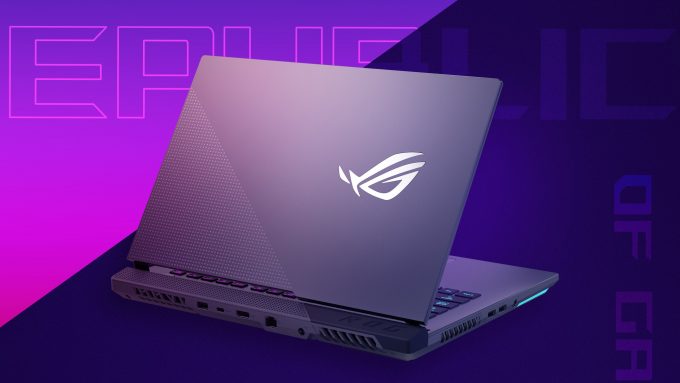 Okay, guys, we were really excited about this day, because, with us, we have one of the most powerful machines for portable gaming money can buy (at least for now). It packs one of the best, if not the best mobile processor on the market right now – the AMD Ryzen 9 5900HX, and can be configured with up to the RTX 3070.
Okay, guys, we were really excited about this day, because, with us, we have one of the most powerful machines for portable gaming money can buy (at least for now). It packs one of the best, if not the best mobile processor on the market right now – the AMD Ryzen 9 5900HX, and can be configured with up to the RTX 3070.
As we saw with the last two reviews we made, manufacturers won’t make it easy for their customers, as the RTX 3070 alone comes in configurations between 80 and 125W. Well, at least this is what NVIDIA states on their webpage. However, NVIDIA also told us that you can check the TGP of your graphics unit via the Control Panel. And when we checked, the information stated 130W, which as we just learned – is above the set maximum.
Nevertheless, we are yet to see what kind of performance improvements we’ll see and how exactly can we access the full power of the ROG Strix G17 G713.
Not in the last place, there are two very interesting display choices. On one hand, there is a 300Hz 1080p IPS panel, made for esports. On the other, there is a crispier 1440p IPS panel, that works at a slightly lower 165Hz refresh rate, but promises a very similar pixel response time.
You can check the prices and configurations in our Specs System: https://laptopmedia.com/series/asus-rog-strix-g17-g713/
Contents
Specs Sheet
- HDD/SSD
- up to 16000GB SSD
- M.2 Slot
- 2x 2280 PCIe NVMe 3.0 x4 See photo
- RAM
- up to 64GB
- OS
- Windows 10 Home, No OS, Windows 11 Home, Windows 10 Pro, Windows 11 Pro
- Battery
- 90Wh, 4-cell
- Body material
- Plastic / Polycarbonate, Aluminum
- Dimensions
- 395 x 282.1 x 23.4 ~ 27.5 mm (15.55" x 11.11" x 0.92")
- Weight
- 2.70 kg (6 lbs)
- Ports and connectivity
- 3x USB Type-A
- 3.2 Gen 1 (5 Gbps)
- 1x USB Type-C
- 3.2 Gen 2 (10 Gbps), Power Delivery (PD), DisplayPort
- HDMI
- 2.0b
- Ethernet LAN
- 10, 100, 1000 Mbit/s
- Wi-Fi
- 802.11ax
- Bluetooth
- 5.1
- Audio jack
- 3.5mm Combo Jack
- Features
- Fingerprint reader
- Backlit keyboard
- Microphone
- Array Microphone
- Speakers
- 2x 4W, Dolby Atmos with Smart Amp
- Optical drive
All ASUS ROG Strix G17 (G713) configurations
What’s in the box?
This notebook’s package is heavily branded. However, inside we only found some paper manuals, a 240W power brick, and the laptop, itself.
Design and construction
Well, the design of this laptop is pretty gamer-ish. There is no doubt that everyone will know what it is about. However, we like the non-intrusive aluminum lid. If we have to be honest, the 2.70 kg weight and the 23.4-27.5mm thickness are not too much for a laptop of this caliber. Well, indeed, the base is made out of plastic, but it has a pleasantly smooth finish and definitely doesn’t feel cheap.
Let’s not forget about the Aura sync light bar that is glowing like an early 2000s Japanese tuner car.
Thankfully, its lid opens with a single hand, and the widely spaced-out hinges feel rather stable. Also, the lid barely flexes when you try to twist it. As for the panel, it has a matte finish, and a very thin top and side bezels. In conjunction with the visual traditions of ROG, the bottom panel has a cut in it. By the way, there is no Webcam to be found anywhere on the device, which is petty.
Looking at the base we see a lot of empty space. And this is to be expected, given the size of the machine. Its keyboard has a per-key RGB backlight, decent key travel, and clicky feedback. All-in-all the unit is good for gaming. As a typical ROG device, the Strix G17 G713 features a set of five dedicated buttons – three for sound/mic control, one that starts the Armoury Crate, and one that toggles between the performance presets. Once again, however, ASUS has decided against adequately-sized Arrow keys, like Lenovo, and then HP demonstrated on their gaming series.
On the bright side, the touchpad is rarely large for a gaming machine. It has a glass cover, which provides a smooth gliding, while the tracking is also surprisingly good. Although some people might not like the fact that it lacks dedicated buttons, we feel that it is one of the better touchpads on the market.
Next, let’s turn the laptop upside down, and see how the ventilation goes. Interestingly, the actual perforations are pretty small in area, contrary to what the grill makes you think. We hope that this doesn’t impede the cooling. At least, there are four exhaust grills – two on the back, and one on each side. Also, the bottom panel is home to the speaker cutouts which house two 4W speakers.
Ports
This device has an I/O that is scattered across the back and the left side. On the back, you will find the charging plug, an RJ-45 connector, an HDMI 2.0b connector, a USB Type-C 3.2 (Gen. 2) port (with Power Delivery, and DisplayPort with G-Sync support), as well as a USB Type-A 3.2 (Gen. 1) port. And when it comes to the left, there are two USB Type-A 3.2 (Gen. 2) ports and an audio jack.
Disassembly, upgrade options, and maintenance
To get inside of this device, you need to undo 11 Phillips-head screws. The one on the top left corner will stay attached, and will gently lift the bottom panel from the chassis. Start your prying process from there and work your way around the device. Before you fully lift the panel away, make sure you disconnect the LED strip ribbon cables.
Inside we see a giant cooling solution, consisting of a total of six heat pipes of various sizes. One of them is common for the CPU and the GPU. There are two more for each processor, and one cooling the graphics memory and the VRM chips.
In terms of upgradability, you get two RAM SODIMM slots, which fit 32GB of DDR4 memory, working at 3200 MHz. Keep in mind that this is the official capacity, stated by the manufacturer, and we are strongly positive that you can put up to 64GB in total. Additionally, there are two M.2 PCIe x4 slots for storage.
Interestingly, ASUS has put an enormous battery pack with a 90Wh capacity.
Display quality
ASUS ROG Strix G17 G713 in the configuration we tested comes with a 300Hz Full HD IPS screen, model number Sharp LQ173M1JW04 (SHP14E1). Its diagonal is 17.3″ (43.94 cm), and the resolution – 1920 х 1080. Additionally, the screen ratio is 16:9, the pixel density – 127 ppi, their pitch – 0.1995 x 0.1995 mm. The screen can be considered Retina when viewed from at least 69 cm (from this distance, the average human eye can’t see the individual pixels).
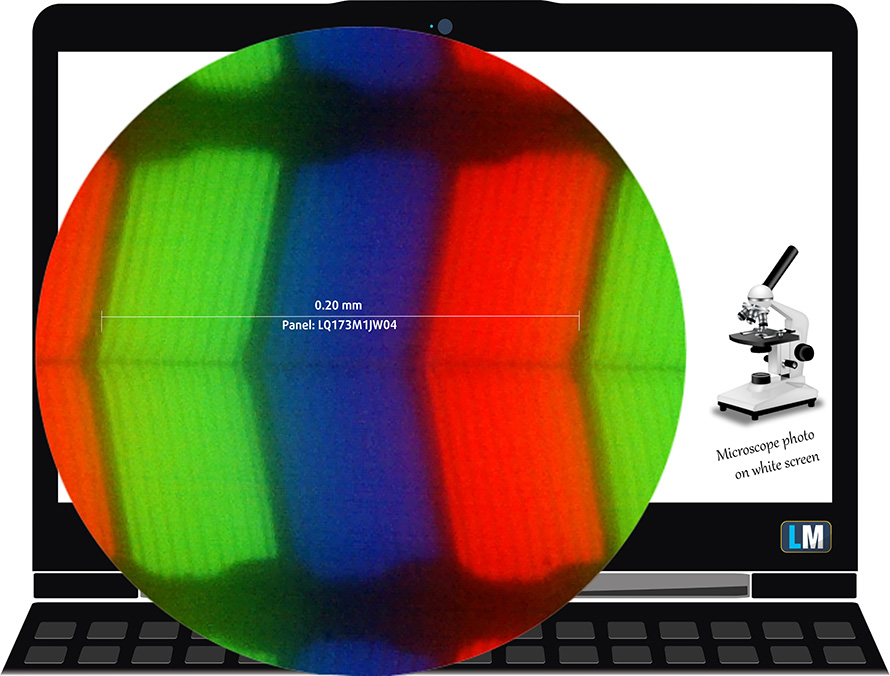
The viewing angles are excellent. We have provided images at 45 degrees to evaluate quality.

The maximum measured brightness is relatively high – 356 nits (cd/m2) in the middle of the screen and remains at the same 353 nits (cd/m2) average across the surface with a maximum deviation of 10%. The Correlated Color Temperature on a white screen and at maximum brightness is 6600K (average) – almost matching the 6500K optimum for sRGB.
In the illustration below you can see how the display performs from a uniformity perspective. The illustration below shows how matters are for operational brightness levels (approximately 140 nits) – in this particular case at 50% Brightness (White level = 141 cd/m2, Black level = 0.11 cd/m2).
Values of dE2000 over 4.0 should not occur, and this parameter is one of the first you should check if you intend to use the laptop for color-sensitive work (a maximum tolerance of 2.0 ). The contrast ratio is good – 1270:1.
To make sure we are on the same page, we would like to give you a little introduction to the sRGB color gamut and the Adobe RGB. To start, there’s the CIE 1976 Uniform Chromaticity Diagram that represents the visible specter of colors by the human eye, giving you a better perception of the color gamut coverage and the color accuracy.
Inside the black triangle, you will see the standard color gamut (sRGB) that is being used by millions of people on HDTV and on the web. As for Adobe RGB, this is used in professional cameras, monitors, etc for printing. Basically, colors inside the black triangle are used by everyone and this is the essential part of the color quality and color accuracy of a mainstream notebook.
Still, we’ve included other color spaces like the famous DCI-P3 standard used by movie studios, as well as the digital UHD Rec.2020 standard. Rec.2020, however, is still a thing of the future and it’s difficult for today’s displays to cover that well. We’ve also included the so-called Michael Pointer gamut, or Pointer’s gamut, which represents the colors that naturally occur around us every day.
The yellow dotted line shows ASUS ROG Strix G17 G713’s color gamut coverage.
Its display covers 95% of the sRGB/ITU-R BT.709 (web/HDTV standard) in CIE1976.
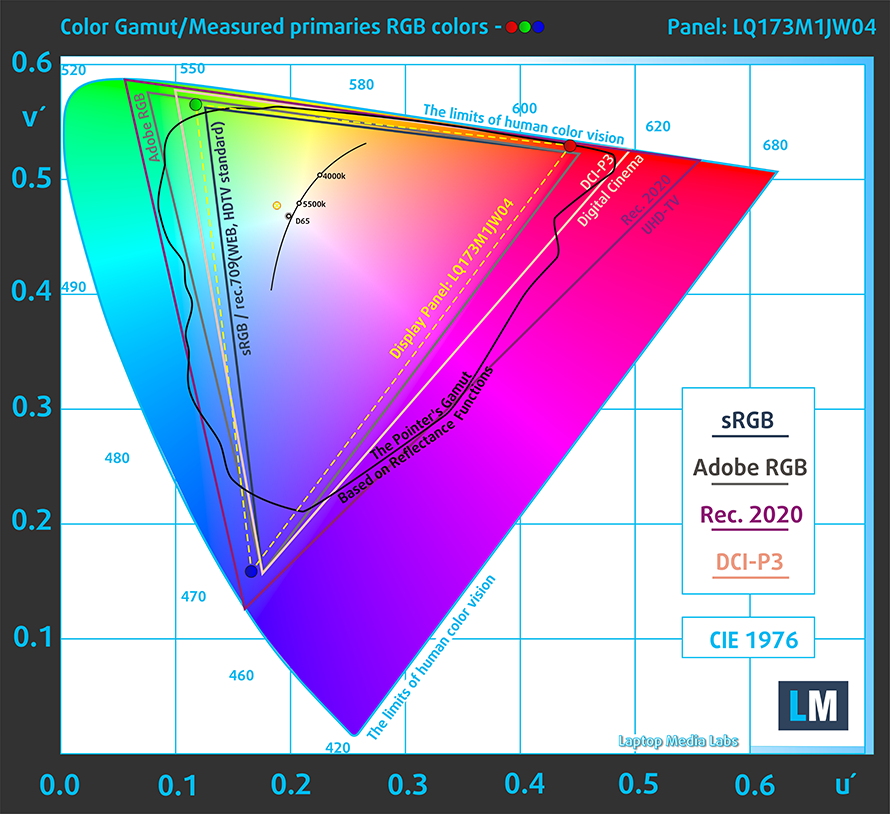
Our “Design and Gaming” profile delivers optimal color temperature (6500K) at 140 cd/m2 luminance and sRGB gamma mode.
We tested the accuracy of the display with 24 commonly used colors like light and dark human skin, blue sky, green grass, orange, etc. You can check out the results at factory condition and also, with the “Design and Gaming” profile.
Below you can compare the scores of ASUS ROG Strix G17 G713 with the default settings (left), and with the “Gaming and Web design” profile (right).
The next figure shows how well the display is able to reproduce really dark parts of an image, which is essential when watching movies or playing games in low ambient light.
The left side of the image represents the display with stock settings, while the right one is with the “Gaming and Web Design” profile activated. On the horizontal axis, you will find the grayscale, and on the vertical axis – the luminance of the display. On the two graphs below you can easily check for yourself how your display handles the darkest nuances but keep in mind that this also depends on the settings of your current display, the calibration, the viewing angle, and the surrounding light conditions.
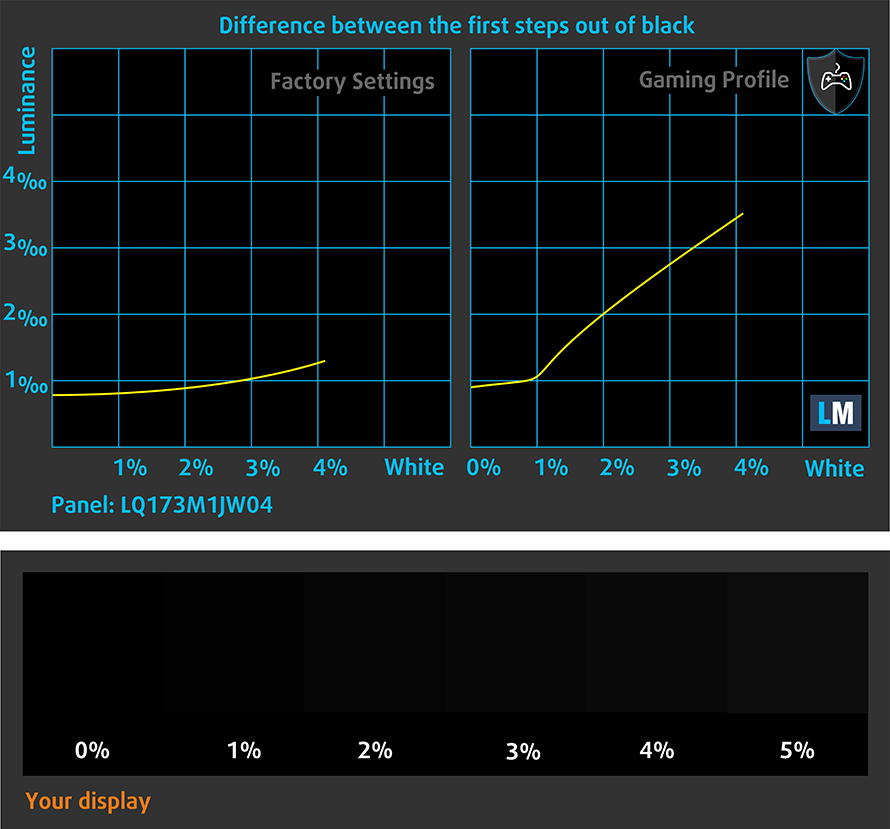
Response time (Gaming capabilities)
We test the reaction time of the pixels with the usual “black-to-white” and “white-to-black” method from 10% to 90% and vice versa.
We recorded Fall Time + Rise Time = 8 ms – super-fast reaction time.

The second graph shows the GtG (Gray to Gray) Response Times from 50% White to 80% White + 80% White to 50% White between the 10% and the 90% amplitudes.
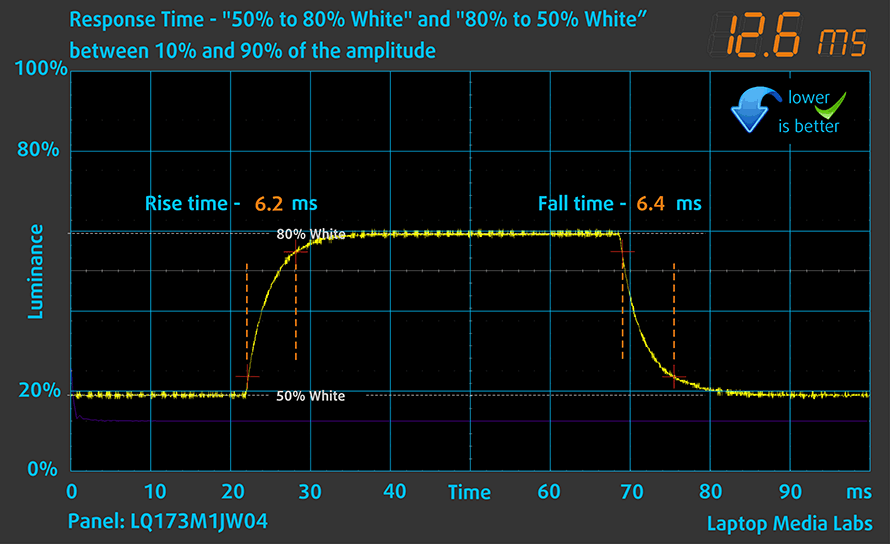
Health impact – PWM / Blue Light
PWM (Screen flickering)
Pulse-width modulation (PWM) is an easy way to control monitor brightness. When you lower the brightness, the light intensity of the backlight is not lowered, but instead turned off and on by the electronics with a frequency indistinguishable to the human eye. In these light impulses, the light/no-light time ratio varies, while brightness remains unchanged, which is harmful to your eyes. You can read more about that in our dedicated article on PWM.
ASUS ROG Strix G17 G713’s display doesn’t use PWM to adjust its brightness levels. This renders it safe for use in prolonged gaming sessions, without the risk of further negatively affecting your health.
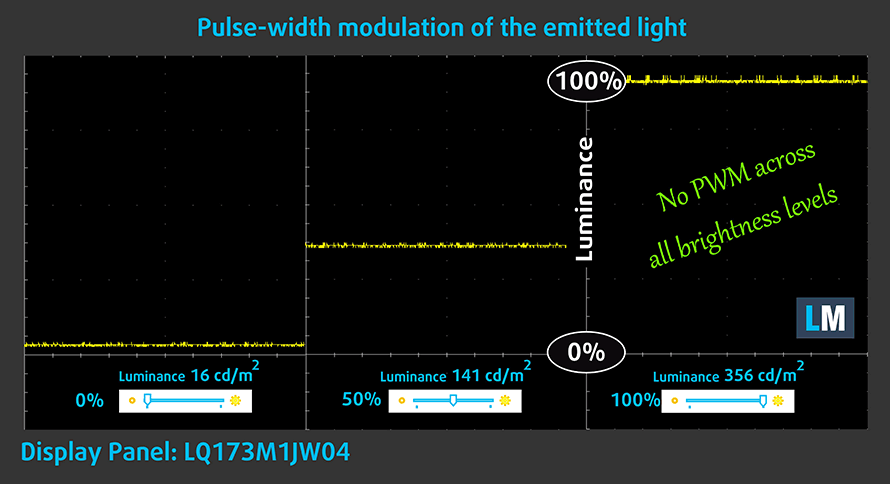
Blue light emissions
Installing our Health-Guard profile not only eliminates PWM but also reduces the harmful Blue Light emissions while keeping the colors of the screen perceptually accurate. If you’re not familiar with the Blue light, the TL;DR version is – emissions that negatively affect your eyes, skin, and your whole body. You can find more information about that in our dedicated article on Blue Light.
Conclusions
ASUS ROG Strix G17 G713’s IPS panel has a Full HD resolution, comfortable viewing angles, good contrast ratio, and a 300Hz refresh rate. This is combined with a quick pixel response time, which results in a blazing sharp image, excellent for gaming. Additionally, with the help of our Gaming and Web design profile, the color accuracy falls into the sRGB standards, which together with the 95% of sRGB gamut coverage, delivers professional-level of performance for artists, designers, and e-commerce.
Buy our profiles
Since our profiles are tailored for each individual display model, this article and its respective profile package are meant for ASUS ROG Strix G17 G713 configurations with 17.3″ Sharp LQ173M1JW04 (SHP14E1) (FHD, 1920 × 1080) IPS.
*Should you have problems with downloading the purchased file, try using a different browser to open the link you’ll receive via e-mail. If the download target is a .php file instead of an archive, change the file extension to .zip or contact us at [email protected].
Read more about the profiles HERE.
In addition to receiving efficient and health-friendly profiles, by buying LaptopMedia's products you also support the development of our labs, where we test devices in order to produce the most objective reviews possible.
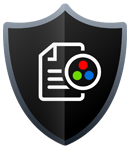
Office Work
Office Work should be used mostly by users who spend most of the time looking at pieces of text, tables or just surfing. This profile aims to deliver better distinctness and clarity by keeping a flat gamma curve (2.20), native color temperature and perceptually accurate colors.
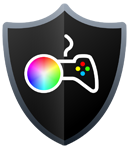
Design and Gaming
This profile is aimed at designers who work with colors professionally, and for games and movies as well. Design and Gaming takes display panels to their limits, making them as accurate as possible in the sRGB IEC61966-2-1 standard for Web and HDTV, at white point D65.
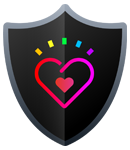
Health-Guard
Health-Guard eliminates the harmful Pulse-Width Modulation (PWM) and reduces the negative Blue Light which affects our eyes and body. Since it’s custom tailored for every panel, it manages to keep the colors perceptually accurate. Health-Guard simulates paper so the pressure on the eyes is greatly reduced.
Get all 3 profiles with 33% discount
Sound
ASUS ROG Strix G17 G713’s speakers produce a sound with decent quality. However, there are deviations throughout the entire frequency range. On the bright side, purely subjectively, the speakers sound loud and deep.
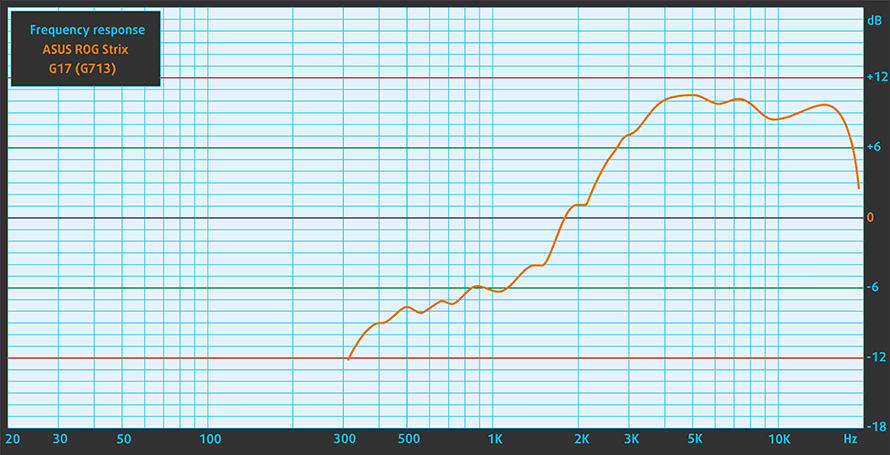
Drivers
All of the drivers and utilities for this notebook can be found here: https://rog.asus.com/laptops/rog-strix/2021-rog-strix-g17-series/helpdesk_download/
Battery
Now, we conduct the battery tests with Windows Better performance setting turned on, screen brightness adjusted to 120 nits, and all other programs turned off except for the one we are testing the notebook with. This notebook’s 90Wh battery lasts for 13 hours and 20 minutes of Web browsing, 9 hours and 24 minutes of video playback, and only 82 minutes of gameplay.
In order to simulate real-life conditions, we used our own script for automatic web browsing through over 70 websites.
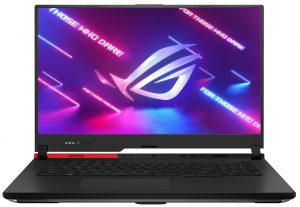
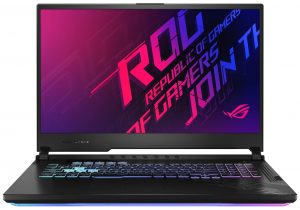
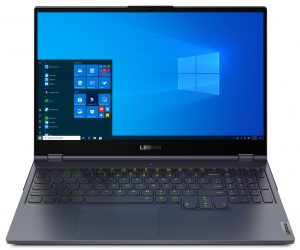
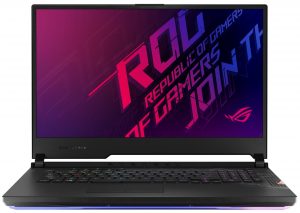
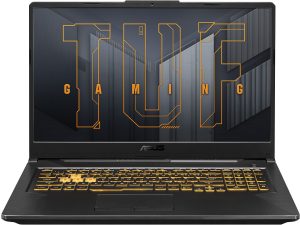
For every test like this, we use the same video in HD.





We use F1 2017’s built-in benchmark on loop in order to simulate real-life gaming.





CPU options
This device comes equipped with one of two high-performance CPUs – the Ryzen 7 5800H, or the Ryzen 9 5900HX.
Results are from the Cinebench 20 CPU test (the higher the score, the better)
Results are from our Photoshop benchmark test (the lower the score, the better)
ASUS ROG Strix G17 (G713) CPU variants
Here you can see an approximate comparison between the CPUs that can be found in the ASUS ROG Strix G17 (G713) models on the market. This way you can decide for yourself which ASUS ROG Strix G17 (G713) model is the best bang for your buck.
Note: The chart shows the cheapest different CPU configurations so you should check what the other specifications of these laptops are by clicking on the laptop’s name / CPU.
Results are from the Cinebench 20 CPU test (the higher the score, the better)
Results are from our Photoshop benchmark test (the lower the score, the better)
GPU options
As for the graphics cards, the current options include the GeForce RTX 3060 (6GB GDDR6), and the GeForce RTX 3070 (130W, 8GB GDDR6).
Results are from the 3DMark: Time Spy (Graphics) benchmark (higher the score, the better)
Results are from the 3DMark: Fire Strike (Graphics) benchmark (higher the score, the better)
Results are from the Unigine Superposition benchmark (higher the score, the better)
ASUS ROG Strix G17 (G713) GPU variants
Here you can see an approximate comparison between the GPUs that can be found in the ASUS ROG Strix G17 (G713) models on the market. This way you can decide for yourself which ASUS ROG Strix G17 (G713) model is the best bang for your buck.
Note: The chart shows the cheapest different GPU configurations so you should check what the other specifications of these laptops are by clicking on the laptop’s name / GPU.
Results are from the 3DMark: Time Spy (Graphics) benchmark (higher the score, the better)
Results are from the 3DMark: Fire Strike (Graphics) benchmark (higher the score, the better)
Results are from the 3DMark: Wild Life (Graphics) benchmark (higher the score, the better)
Results are from the Unigine Superposition benchmark (higher the score, the better)
Gaming tests

| Far Cry 5 | Full HD, Normal (Check settings) | Full HD, High (Check settings) | Full HD, Ultra (Check settings) |
|---|---|---|---|
| Average | 120 fps | 115 fps | 109 fps |

| Rise of the Tomb Raider (2016) | Full HD, Medium (Check settings) | Full HD, Very High (Check settings) | Full HD, MAX (Check settings) |
|---|---|---|---|
| Average | 145 fps | 108 fps | 77 fps |

| Tom Clancy’s Ghost Recon Wildlands | Full HD, High (Check settings) | Full HD, Very High (Check settings) | Full HD, Ultra (Check settings) |
|---|---|---|---|
| Average | 106 fps | 95 fps | 67 fps |

| Shadow of the Tomb Raider (2018) | Full HD, Medium (Check settings) | Full HD, High (Check settings) | Full HD, Highest (Check settings) |
|---|---|---|---|
| Average | 113 fps | 110 fps | 90 fps |
Temperatures and comfort
Max CPU load
In this test we use 100% on the CPU cores, monitoring their frequencies and chip temperature. The first column shows a computer’s reaction to a short load (2-10 seconds), the second column simulates a serious task (between 15 and 30 seconds), and the third column is a good indicator of how good the laptop is for long loads such as video rendering.
Average core frequency (base frequency + X); CPU temp.
| AMD Ryzen 9 5900HX (45W TDP) | 0:02 – 0:10 sec | 0:15 – 0:30 sec | 10:00 – 15:00 min |
|---|---|---|---|
| ASUS ROG Strix G17 G713 | 3.44 GHz (B+4%) @ 70°C | 3.38 GHz (B+2%) @ 72°C | 3.44 GHz (B+4%) @ 71°C |
Although the frequency in extreme stress scenarios is close to the base, we are happy to see that the liquid metal thermal compound does its job, as it doesn’t allow the CPU to work at more than 72°C.
Real-life gaming
| NVIDIA GeForce RTX 3070 | GPU frequency/ Core temp (after 2 min) | GPU frequency/ Core temp (after 30 min) |
|---|---|---|
| ASUS ROG Strix G17 G713 | 1649 MHz @ 83°C @ 130W | 1646 MHz @ 84°C @ 130W |
| ASUS TUF A17 (FA706) 2021 | 1440 MHz @ 74°C @ 95W | 1465 MHz @ 77°C @ 95W |
| ASUS TUF Dash F15 (FX516) | 1389 MHz @ 69°C @ 84W | 1377 MHz @ 74°C @ 84W |
As you can see, the 130W version of the RTX 3070 works at a significantly higher clock speed – about 200 MHz above the 95W one and 270 MHz above the 85W. Our tests were run with the Turbo mode enabled, and its default fan curves. Keep in mind that you can adjust the fans to max out at any temperature you want, thus reducing the maximum temp (by single digits we think).
Gaming comfort
Interestingly, even though the GPU reached 84°C, the external temperature remained pretty much in check… as ASUS said. However, the notebook tends to be a bit noisy.


Verdict
 Another day has passed, and another RTX 3070 machine has gone through our office. This time, it was the most potent of them all – the 130W version. As a matter of fact, it might be the most powerful mobile GPU, before the RTX 3080 arrives. We saw a similar, and slightly better performance than the RTX 2080 Super, but at 20W lower TGP. Interestingly, the latter is still better when it comes to the Heaven 4 and 3DMark Fire Strike benchmarks. Also, we noticed that on lower details, the RTX 2080 Super paired with a Core i9-10980HK managed to pull ahead. This means only one thing – the mobile Ryzen 5000 chips are not yet ready to be crowned gaming kings.
Another day has passed, and another RTX 3070 machine has gone through our office. This time, it was the most potent of them all – the 130W version. As a matter of fact, it might be the most powerful mobile GPU, before the RTX 3080 arrives. We saw a similar, and slightly better performance than the RTX 2080 Super, but at 20W lower TGP. Interestingly, the latter is still better when it comes to the Heaven 4 and 3DMark Fire Strike benchmarks. Also, we noticed that on lower details, the RTX 2080 Super paired with a Core i9-10980HK managed to pull ahead. This means only one thing – the mobile Ryzen 5000 chips are not yet ready to be crowned gaming kings.
However, they can surely be considered as computational monstrosities, as the Ryzen 9 5900HX climbed to the top of our CPU Ranking. And although the ROG Strix G17 G713 is mostly about performance, we found out that it packs great battery life – 13 hours and 20 minutes of Web browsing, and 9 hours and 24 minutes of video playback. Exceptional, considering that our unit came with the 300Hz 1080p IPS display. By the way, this is not only due to the large 90Wh package but also because of the variable refresh rate, which adjusts to the content you are viewing.
ASUS ROG Strix G17 G713’s IPS panel has a Full HD resolution, comfortable viewing angles, good contrast ratio, and a 300Hz refresh rate. This is combined with a quick pixel response time, which results in a blazing sharp image, excellent for gaming. Additionally, with the help of our Gaming and Web design profile, the color accuracy falls into the sRGB standards, which together with the 95% of sRGB gamut coverage, delivers professional-level of performance for artists, designers, and e-commerce.
And if you are a fan of RGB, there are lots of it around here – the keyboard has a per-key illumination, meaning that each key can be configured independently. Also, the light strip on the bottom panel is here to stay.
Another perk to the notebook is its upgradability. Two RAM SODIMM slots, that pack up to 64GB of DDR4 RAM, and two M.2 PCIe x4 slots for storage. Speaking of the internals, there is a set of 4W speakers which sound loud and deep, and are good both for music and entertainment.
Although we were not extremely happy to see mostly plastic on ROG Strix G17 G713’s chassis, it’s good that it isn’t a low-quality one, and the actual finish feels good.
In fact, there are very few things we didn’t like about this laptop. First – the lack of an SD card reader and Thunderbolt. Although the latter is inevitable, because of the AMD chipset, we can’t say the same for SD cards. Considering the immense amount of power inside of this notebook, it would have been great to quickly access your photos and videos for editing on the go.
Another thing is the Arrow key size. Once again, ASUS remains in the shadow of Lenovo and HP, with their respective Legion and Omen devices.
By the way, the processor here has liquid metal between itself, and the cooling element, which greatly improves the thermal efficiency. However, the GPU uses an orthodox thermal paste, and we saw temperatures on the GPU that are a bit higher than optimal. Perhaps in the future, we might find a way to lower it through undervolting or applying liquid metal on the GPU, as well.
So, tell us in the comments, do you prefer the full-blown version of the RTX 3070, or you are good enough with the 95W, inside of the much less expensive ASUS TUF A17 (FA706) 2021.
Pros
- Good keyboard with decent travel, clicky feedback, and an RGB backlight
- 130W RTX 3060 / 3070 onboard
- Uses liquid metal for the CPU
- There are two M.2 PCIe slots, and two RAM SODIMM slots in dual channel, and Wi-Fi 6
- Great battery life for a gaming laptop
- 300Hz 1080p IPS panel, or a 165Hz 1440p IPS one
Cons
- Lacks an SD card reader and Thunderbolt support
- GPU warms up pretty quickly during gaming
- Tiny Arrow keys
You can check the prices and configurations in our Specs System: https://laptopmedia.com/series/asus-rog-strix-g17-g713/


























































The 130W on the 3070 actually means a 115W variant + potentially 15W Dynamic boost. If you compare the clock speeds with the Geforce RTX 30 variant list posted on videocardz you can see that it fits exactly into that.
question is … when you need to reapply the liquid metal or thermal compound? it has to be done some time
In 2 years normally
Do you know if you can install SATA M.2 SSDs on the PCIe M.2 slots?
A common mistake. The panels here are not IPS.
300Hz panel manufactured by Sharp using VA technology (17,3“ Sharp SHP14E1 LQ173M1JW04).
They call it IPS-level (sayng that their monitor pefrorms as IPS panel. But it is not IPS!) that confuses all customers.
The result for Shadow of Tomb Rider are exactly same as my full desktop pc with a I7 10700 125w, rtx 2070s, 32ddr 3200, nvme, win10, and I think that is just amazing to be able to achieve with a 45W cpu+ 115W gpu.
I cant delete the comment but the benchmark result on this page is not accurate for Shadow of Tomb Rider
I ran the Shadow of the Tomb Rider again same exact highest settings as you had with SMAA4x and I can say something isn’t right with your results, there’s no way this laptop scored 90fps. Please revisit your results!
Purchase date – 24th of February 2021
Death date – 24th of March 2021
Before I had been using ASUS device once. 10 years ago got a transformer T300. Worked 13 month till death. Been proposed a full price of the transformer to replace a motherboard. Gave a word to self never purchase ASUS.
Now I broke my word and purchase this “premium” device.
1 month (!!!!) of life.
ASUS, are u kiddin’ me????
my experience with this laptop has been exceedingly poor. Battery while gaming lasts about 30 min literally, then it starts lagging because the saver cuts everything when below 10% power. This is starting from a 100% full plugged in overnight battery. Battery non gaming lasts about an hour, maybe 2 if I have battery saver on. As I type this now I have 17% battery left and started the computer up at 9:10 from 100% full plugged in status. It is 9:55 now and I have done 0 gaming. I have a 5 year old ACER with a g920 chip… Read more »
I bought the Asus ROG Strix G713QR-ES96Q on 12/9/2021 for $1900. It has Ryzen R9-5900HX and Nvidia GeForce RTX 3070 with the WQHD display (2560 x 1440). It seemed like a great deal at the time. The picture is beautiful and very high definition. However after about 9 months, it would constantly switch from charging to battery. Rotating the power plug to a different position fixed the problem for another 9 months until I could barely find a position to get it to charge. I never put any stress on the cord. Looking into the power jack with a flashlight… Read more »